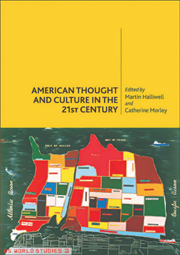Book contents
- Frontmatter
- Contents
- Acknowledgements
- Notes on the Contributors
- Introduction: The Next American Century?
- PART 1 POLITICS
- 1 American Politics in the 1990s and 2000s
- 2 American Leadership into the New Century
- 3 9/11 and US Foreign Policy
- 4 Three Variations on American Liberalism
- 5 The Rise of Postmodern Conservatism
- 6 US Propaganda
- PART 2 SOCIETY
- PART 3 CULTURE
- Bibliography
- Index
1 - American Politics in the 1990s and 2000s
from PART 1 - POLITICS
Published online by Cambridge University Press: 05 August 2013
- Frontmatter
- Contents
- Acknowledgements
- Notes on the Contributors
- Introduction: The Next American Century?
- PART 1 POLITICS
- 1 American Politics in the 1990s and 2000s
- 2 American Leadership into the New Century
- 3 9/11 and US Foreign Policy
- 4 Three Variations on American Liberalism
- 5 The Rise of Postmodern Conservatism
- 6 US Propaganda
- PART 2 SOCIETY
- PART 3 CULTURE
- Bibliography
- Index
Summary
On 11 June 2004, the American people bade farewell to President Ronald Reagan with a day of mourning on a scale not seen for 30 years. For Reagan's funeral, the first such state occasion since the death of Lyndon Johnson in 1973, the nation appeared united in grief. A few days earlier, more than 100,000 people had filed past the former governor's coffin at his presidential library in California. In Washington, a similar number queued to pay their respects as Reagan lay in state at the Capitol Rotunda. And on the day of the funeral itself, every American military base in the world fired a 21-gun salute in Reagan's honour, while church bells across the nation tolled 40 times and several states held a minute's silence. Breaking off from an agonisingly close re-election campaign, President George W. Bush told the nation that ‘when the sun sets … a great American story will close.’
That Reagan would be deeply mourned on the right, among the conser vatives who had propelled him into office and by the Republican Party whose success he had done so much to assure, was no surprise. Some called for him to replace Alexander Hamilton on the ten-dollar note or John Kennedy on the half-dollar coin, while the Senate Republican leader Bill Frist even suggested that the Pentagon be renamed in his honour.
- Type
- Chapter
- Information
- American Thought and Culture in the 21st Century , pp. 21 - 34Publisher: Edinburgh University PressPrint publication year: 2008



